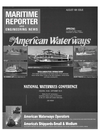
Page 17: of Maritime Reporter Magazine (August 1991)
Read this page in Pdf, Flash or Html5 edition of August 1991 Maritime Reporter Magazine
IMO Moves Ahead
On Double-Hull Tankers
The International Maritime Or- ganization (IMO) recently agreed to greatly alter international legisla- tion covering tanker design, thus paving the way for the introduction of double-hull ships.
In intense negotiations, IMO's
Marine Environment Protection
Committee (MEPC) agreed to dis- tribute a set of proposals to member governments which provide an out- line for the introduction of double- hull tankers and requirements for the retrofits of existing tankers.
The retrofit issue is one of the most radical proposals being put forth.
Although double-hull tankers that have been built since the Exxon
Valdez accident will be exempt, even if they don't meet the new require- ments, shipowners of current single- hull ships would face the options of either scrapping vessels or under- taking expensive retrofits.
The new proposals under consid- eration would require all tankers of 3,000 deadweight tons and up to be fitted with a double hull with a mini- mum air space of 1 meter or about three feet between hulls.
MEPC, however, in a concession to the oil industry, has agreed to consider alternate designs if they are proven to provide the same pro- tection as a double hull.
A study group funded by industry and under the auspices of the IMO will examine the effectiveness of al- ternative designs. The group will report its findings by the end of the year.
The results of the study will help the MEPC finalize the new regula- tions at the next meeting. They would probably come into force in 1993 or 1994.
Coast Guard Selects 19 Cities For Storage
Of Oil Spill Equipment
In accordance with the Oil Pollu- tion Act of 1990, the U.S. Coast
Guard recently released the list of cities it has selected for the storage of marine oil spill response equip- ment such as skimmers and booms.
The cities selected by the Coast
Guard are: Boston, Mass.; New Lon- don, Conn.; Portsmouth, Va.;
Charleston, S.C.; Miami, Mayport, and Tampa, Fla; New Orleans, La.;
Detroit, Mich.; Corpus Christi and
Galveston, Texas; Long Beach and
Eureka, Calif.; Seattle, Wash.; Ho- nolulu, Hawaii; Astoria, Ore.; An- chorage, Alaska; and San Juan,
Puerto Rico.
The petroleum industry has re- sponded to OPA by forming the
Marine Spill Response Corporation, a non profit organization, which is setting up a network of five oil spill response centers around the coun- try. Port Hueneme, Calif., has been selected as one of the sites already.
Negotiations are also underway with
Miami as a possible second site.
Megapulse 'Accufix 500'
Loran Receiver Selected
For U.S. Navy Programs
Megapulse, Inc., Bedford, Mass., designer and manufacturer of solid- state Loran-C systems, has had their
Accufix 500 precision monitoring and survey grade Loran-C receiver selected by the U.S. Navy for the
M.S.O. (oceangoing minesweeper),
COOP (craft of opportunity ), and
MCM (mine countermeasures) pro- grams.
The Accufix 500 Loran receiver is specified for the MHC-51 (mine hunter coastal) class program.
This will ensure a common Lo- ran-C sensor for ease of training and program management throughout the present and planned U.S. Navy mine-warfare fleet. After the cur- rent contract completion, a total of 95 receivers and notch filters will be in operation. Some of these units were operated by the U.S. Navy dur- ing the Iran/Iraq war for 24 hours a day precision navigation require- ments.
For free literature on Megapulse solid-state Loran-C systems,
Circle 47 on Reader Service Card techniques, the only choice when it came to selecting the propulsion system for a new ferry was Hamilton Jet. A 33 metre, 35 knot passenger ferry built by Goriki Shipyard, "Nyenufabushi" was commissioned to carry passengers quickly between offshore islands. Crucial design factors were high speed, reliability, passenger comfort and outstanding manoeuvrability. Construction had to be certified to NKK standards. All these were met using the advanced technology and innovative features found only in Hamilton waterjets, adding "Goriki Shipyard" to an impressive and ever growing reference list of satisfied customers worldwide.
Hamilton Jet has built its reputation on providing the best marine jet propulsion systems anywhere in the world. That's why designers from the most technically advanced nations recognise New Zealand quality and expertise and have confidence in specifying Hamilton Jet.
The world's top shipbuilders turn to New Zealand for waterjets
With waterjets the preferred propulsion system for new age fast ferries, work and patrol boats, commercial influences demand reliability and engineering excellence. That's why more and more shipbuilders are turning to New Zealand, the home of Hamilton Jet.
For Japan, a nation leading the way in advanced technology and quality assurance
Highly Specified. Hamilton Jet
Manufactured In New Zealand by CWF Hamilton and Co Ltd. P.O. Box 709. Christchurch, New Zealand. Ph: +64-3-3484-179, Fax: +64-3-3486-969.
Worldwide Distributors — Italy. Spain, UK USA. Canada. India, France. Germany. Holland. Australia, Finland. Hong Kong,
Indonesia. Korea. Norway. Singapore. Sweden. Taiwan, Japan. Malaysia. Thailand. Denmark, Phillipines, Panama. CWF0034
Circle 229 on Reader Service Card
August, 1991 19

 16
16

 18
18
